
|
Glossary Illustrated S - 1 |







(alphabetical and illustrated) Introduction | A - 1 | A - 2 | B - 1 | B - 2 | C - 1 | C - 2 | C - 3 | D | E | F G - H | I - J - K | L - M | N - O | P | Q - R | S - 1 | S - 2 | T | U - V - W - X - Y - Z |
|
|
|
|
| a mocking, ridiculing commentary on an economic, political, religious or social institution, ideology or belief, person (or group), policy, or human vice. | Examples: The Great Dictator (1940), Dr. Strangelove, Or How I Learned to Stop Worrying And Love the Bomb (1964), Brazil (1985) | |
| (1) the outline for a screenplay, or (2) a complete screenplay | ||
| usually a shot (or series of shots) that
together comprise a single, complete and unified dramatic event, action,
unit, or element of film narration, or block (segment) of storytelling
within a film, much like a scene in a play; a scene normally occurs
in one location and deals with one action; the end of a scene
is often indicated by a change in time, action and/or location; see also shot and sequence. |
 Example:
The classic love scene of John Wayne and Maureen O'Hara caught in a
drenching rainstorm in a graveyard, and their rain-soaked embrace in The
Quiet Man (1952) Example:
The classic love scene of John Wayne and Maureen O'Hara caught in a
drenching rainstorm in a graveyard, and their rain-soaked embrace in The
Quiet Man (1952) |
|
| refers to the outdoor background in a set (represented by either a backdrop or a natural view). | ||
| usually refers to a character (or group of characters), usually subsidiary, whose appearance, actions and/or dialogue draws more attention than other actors in the same scene; similar to the term 'chewing up the scenery.' | Examples: Tim Curry as Darkness in Legend (1985); William Bendix as Jeff in The Glass Key (1942); John Gielgud as Hobson the butler in Arthur (1981) | |
| from the Yiddish expression for 'inferior' - refers to a forgettable, cheaply-made, low-budget, luridly-advertised B-film (or lower Z-film) with little or non-existent quality - often unintentionally hilarious; designed to take in profitable box-office in opening week; usually films found in the horror, comedy and science-fiction genres of the 50s and 60s. | Examples: Films from AIP (American International Pictures); also Robot Monster (1953) and The Giant Claw (1957), Sex Kittens Go to College (1960) | |
| the musical component of a movie's soundtrack, usually composed specifically for the film by a film composer; the background music in a film, usually specially composed for the film; may be orchestral, synthesized, or performed by a small group of musicians; also refers to the act of writing music for a film |  Examples:
Bernard Herrmann's memorable score with screeching violins for Hitchcock's Psycho
(1960) or the score for The Wizard of
Oz (1939) Examples:
Bernard Herrmann's memorable score with screeching violins for Hitchcock's Psycho
(1960) or the score for The Wizard of
Oz (1939) |
|
| refers to the direction that characters or objects are moving in a film's scene or visual frame; common screen directions include "camera left" (movement to the left) or "camera right" (movement to the right); a neutral shot is a head-on shot of a subject with no evident screen direction; a jump-cut often indicates a change in screen direction | ||
| refers to a filmed audition in which an actor performs a particular role for a film production; casting often depends upon the photogenic (the projection of an attractive camera image) quality of the star. | ||
| the term for a promotional DVD (or video) version of a film that is sent to voters (and film critics) by the movie studios for their convenience during the awards season, before the movie is officially available to the public through video rental chains | ||
| the exhibition or display of a movie, typically at a cinema house/theatre; to screen (or unspool) a film means to show or project a film; types of screenings include a critical screening (a pre-release viewing for film critics), a pre-screening, or a focus-group screening (to test audience reactions to a film's rough cut); cinema is another term for a movie theatre. | ||
| a script or text for a film production written by a scripter or screenwriter(s) (or scribe), written (scribbled, scripted, or penned) in the prescribed form as a series of master scenes, with all the dialogue provided and the essential actions and character movements described; a script is written to be made into a movie; screenplays are often adaptations of other works; known archaically as a photoplay during the silent era. |
|
|
| the scripter who writes an original film screenplay or adapts another work into a film | ||
| a type of highly-verbal comedy prevalent in 1930's Hollywood, and typified by frenetic action, verbal wit and wisecracks (substituting or serving as a metaphoric euphemism for sex), a battle of the sexes with conflict that is ultimately resolved - all elements that serve as important plot points. | Examples: Capra's It Happened One Night (1934) and Hawks' Bringing Up Baby (1938) and His Girl Friday (1940); My Man Godfrey (1936), The Awful Truth (1937), Sturges' The Palm Beach Story (1942), and Cukor's The Philadelphia Story (1940). | |
(also shooting script) |
refers to the written text of a film - a blueprint for producing a film detailing the story, setting, dialogue, movements and gestures of actors, and the shape and sequence of all events in the film; in various forms, such as a screenplay, shooting script, breakdown script (a very detailed, day-to-day listing of all requirements for shooting, used mostly by crew), lined script, continuity script, or a spec script (written to studio specifications); a screenplay writer is known as a screenwriter, scripter, scribbler, scribe or penner; a last-minute script re-writer is known as a script doctor; a scenario is a script that includes camera and set direction as well as dialogue and cast direction; a shooting script is a detailed final version of the screenplay with the separate scenes arranged in proper sequence, and used by the cast during actual film-making. | 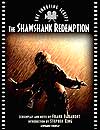 Example
of shooting script, for The Shawshank Redemption
(1994) Example
of shooting script, for The Shawshank Redemption
(1994) |
| in general terms, an actor who plays a subordinate or secondary role; aka second fiddle; in comedies, it refers to a performer who acts as a sidekick, foil or stooge (straight man) to a lead comedian | Examples: Dean Martin was a 'second banana' to Jerry Lewis when they were a comic duo; or Bud Abbott to Lou Costello; or Ralph Bellamy to Cary Grant in His Girl Friday (1940); also, Ward Bond as a secondary player in many westerns | |
| in larger film productions, this refers to the less important scenes (large crowd scenes, scenery, foreign location backgrounds, various inserts, etc.) that are filmed by a smaller, secondary or subordinate crew, usually headed by a second-unit director; contrast to principal photography | ||
| a section or episode of a film; a series of sequences that comprise a major section of the plot; segmentation of a film often helps to further analysis | ||
| an industry term meaning prerecorded videocassettes or DVDs priced lower, to encourage their sale rather than rental | ||
| a black-and-white image that has been converted to a sepia tone or color (a brownish gray to a dark olive brown) in order to enhance the dramatic effect and/or create an "antique" appearance |  Example:
the black and white print for Cabin in the Sky (1943) was reprocessed
as sepia-toned to create a more flattering skin tone for the actors;
also an opening sequence (pictured) in Butch
Cassidy and the Sundance Kid (1969) Example:
the black and white print for Cabin in the Sky (1943) was reprocessed
as sepia-toned to create a more flattering skin tone for the actors;
also an opening sequence (pictured) in Butch
Cassidy and the Sundance Kid (1969) |
|
| a cinematic work that presents the continuation of characters, settings, and/or events of a story in a previously-made or preceding movie; contrast to a prequel, follow-up, serial, series, spin-off or remake. | Examples: The Maltese Falcon (1941) followed by The Black Bird (1975); National Velvet (1944) followed by International Velvet (1978); A Man and a Woman (1966) followed by A Man and a Woman: 20 Years Later (1986); generally, sequels are inferior - with some exceptions, such as The Godfather, Part II (1974), Toy Story 2 (1999), The Empire Strikes Back (1980), X2: X-Men United (2003), etc. | |
| a scene, or connected series of related scenes that are edited together and comprise a single, unified event, setting, or story within a film's narrative; also refers to scenes that structurally fit together in the plot; sequence usually refers to a longer segment of film than a scene; sequences are often grouped into acts (like a three-act play); a sequence shot refers to a long, normally complicated shot with complex camera movements and actions; see also shot and scene. | Examples: the wedding sequence in The Godfather (1972), the drug-bust sequence in GoodFellas (1990) | |
| a multi-part, 'short-subject' film that was usually screened a chapter/episode per week at a film theatre; the predominant style of the serial was melodrama; often, each chapter or episode, continually presented in installments over several weeks, would conclude with an unresolved cliffhanger to ensure that audience would return the following week to discover the resolution; popular until the early 1950s; contrast with series and sequels. |  Example: The
Perils of Pauline (1914). Example: The
Perils of Pauline (1914). |
|
| a string or sequence of films with shared situations, characters or themes and related titles, but with little other inter-dependence, especially with respect to plot or significant character development. Usually presented without cliffhangers; the term also applies to feature films with more than one sequel; contrast with serials and sequels. | Examples of films made in series: The Thin Man (1934), Blondie (1938), Superman (1978), Rocky (1976), Star Trek - The Motion Picture (1979), the James Bond 007 films, and Planet of the Apes (1968). | |
| the environment (an exterior or interior locale) where the action takes place in a film; when used in contrast to location, it refers to an artificially-constructed time/place (a backdrop painting or a dusty Western street with a facade of storefronts); supervised by the film's art director; strike refers to the act of taking apart a set once filming has ended. |  Example:
the War Room set, production-designed for Dr.
Strangelove, Or: How I Learned to Stop Worrying and Love the Bomb (1964). Example:
the War Room set, production-designed for Dr.
Strangelove, Or: How I Learned to Stop Worrying and Love the Bomb (1964). |
|
| usually a self-contained, elaborate scene or sequence that stands on its own (i.e., a helicopter chase, a dance number, a memorable fight, etc.), and serves as a key moment in the film; in terms of production, it may also refer to a scene with a large set |  Examples:
the Death Star trench run in Star Wars (1977),
the attack on a Vietnamese village by helicopters in Apocalypse
Now (1979), the snake pit sequence in Raiders
of the Lost Ark (1981), the musical duet-dance on a giant electronic
keyboard in Big (1988), and the bullet-dodging sequence in The
Matrix (1999). Examples:
the Death Star trench run in Star Wars (1977),
the attack on a Vietnamese village by helicopters in Apocalypse
Now (1979), the snake pit sequence in Raiders
of the Lost Ark (1981), the musical duet-dance on a giant electronic
keyboard in Big (1988), and the bullet-dodging sequence in The
Matrix (1999). |
|
| the time (time period) and place in which the film's story occurs, including all of the other additional factors, including climate (season), landscape, people, social structures and economic factors, customs, moral attitudes, and codes of behavior; aka locale. | ||
| the place or position where the director and the director of photography put the camera (and lighting) when shooting a scene; a scene is usually shot with multiple setups and with multiple takes from each setup; aka angle. | ||
(screenplay) |
in screenplay terms, set-up refers to the first act in which the characters, situation, and the setting are established. | Example: the 'first act' of The Wizard of Oz (1939) before the Technicolor sequences in the Land of Oz |
| a humorous, light-hearted film with an improbable plot about sexual relationships and extra-marital affairs, with various pairings between numerous characters, often characterized by slamming doors; aka sex farce or bedroom farce. | Examples: Woody Allen's A Midsummer Night's Sex Comedy (1982), Hal Ashby's Shampoo (1976), the Italian film Casanova 70 (1965). | |
| refers to non-pornographic, non-explicit, soft-core films that feature sexual themes or explicit sexual material and nudity often in an apparently crude, immature, leering way; these films exploited the concept of sex without violating long-standing cultural and legal taboos against showing it all on the screen; often with lurid titles; aka skin flick | 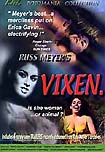 Examples:
the films of Russ Meyers, such as Faster, Pussycat! Kill! Kill! (1966), Vixen
(1968). Examples:
the films of Russ Meyers, such as Faster, Pussycat! Kill! Kill! (1966), Vixen
(1968). |
|
(or story) |
a long-winded, overly convoluted, often irrelevant, protracted or complicated plot, tale or storyline, that often pointlessly or meaninglessly ends up (sometimes after an extensive quest or search) with no resolution at all or with an anti-climax | Example: The 'contract' scene in the Marx Brothers' A Night at the Opera (1935), The Wizard of Oz (1939), Monty Python and the Holy Grail (1975), Raiders of the Lost Ark (1981), The Usual Suspects (1995), U Turn (1997), The Big Lebowski (1998), Burn After Reading (2008) |
| the process of filming or photographing any aspect of a motion picture with a camera; the plan for a shoot is termed a shooting schedule. |  Example:
a 'behind-the-scenes' look at the shooting of the "Yellow Brick
Road"
scene in The Wizard of Oz (1939) Example:
a 'behind-the-scenes' look at the shooting of the "Yellow Brick
Road"
scene in The Wizard of Oz (1939) |
|
(short or short films) |
a film that is shorter than around 30 or 45 minutes, and definitely less than 60 minutes; in the silent film era, most films were shorts, such as those shown in nickelodeons; then, during the early film era, the price of a movie ticket included not only the weekly feature but also "selected short subjects," as they were usually billed; contrast to feature films. | 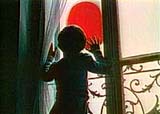 Examples:
the 1930s talkie shorts of Our Gang or The Little Rascals from
Hal Roach Studios; the Pete Smith Specialties short subject films
(from the mid-1930s to mid-1950s); MGM's crime dramas and investigative
exposes - Crime Does Not Pay shorts (from the mid-1930s to mid-1940s);
Warners' popular Joe McDoakes series in the 1940s and 1950s; Robert
Benchley's series of comedy shorts; MGM's one-reel Dogville comedies;
also the Oscar-winning childhood fantasy short, The Red Balloon (1956,
Fr.) (pictured) Examples:
the 1930s talkie shorts of Our Gang or The Little Rascals from
Hal Roach Studios; the Pete Smith Specialties short subject films
(from the mid-1930s to mid-1950s); MGM's crime dramas and investigative
exposes - Crime Does Not Pay shorts (from the mid-1930s to mid-1940s);
Warners' popular Joe McDoakes series in the 1940s and 1950s; Robert
Benchley's series of comedy shorts; MGM's one-reel Dogville comedies;
also the Oscar-winning childhood fantasy short, The Red Balloon (1956,
Fr.) (pictured) |
|
|
the basic building block or unit of film narrative; refers to a single, constant take made by a motion picture camera uninterrupted by editing, interruptions or cuts, in which a length of film is exposed by turning the camera on, recording, and then turning the camera off; it can also refer to a single film frame (such as a still image); a follow-shot is when the camera moves to follow the action; a pull-back shot refers to a tracking shot or zoom that moves back from the subject to reveal the context of the scene; see also scene and sequence; shot analysis refers to the examination of individual shots; a one-shot, a two-shot, and a three-shot refers to common names for shooting just one, two, or three people in a shot |
 Example
of a single film frame or shot, of Fay Wray rehearsing the moment of meeting
Kong, from King Kong (1933). Example
of a single film frame or shot, of Fay Wray rehearsing the moment of meeting
Kong, from King Kong (1933). |
|
|
a shot, scene, and sequence together make up the larger dramatic narrative of film; scenes are composed of shots, sequences are composed of scenes, and films are composed of sequences. | |
| the list distributed and used by a film crew of all the shots to be filmed during the day | ||
| refers to the length of time a single frame is exposed | ||
| aka visual gag; an image that conveys humor visually, usually non-verbally; often used in silent film comedy, or in films with very little dialogue. |  Example: all silent film comedies, Jacques Tati's Playtime (1967), the animated film The Triplets of Belleville (2003), or the scene of Cameron Diaz with semen as her hair-gel in There's Something About Mary (1998) (pictured), or numerous examples from James Bond films, such as Moonraker (1979) (pictured) - Example: all silent film comedies, Jacques Tati's Playtime (1967), the animated film The Triplets of Belleville (2003), or the scene of Cameron Diaz with semen as her hair-gel in There's Something About Mary (1998) (pictured), or numerous examples from James Bond films, such as Moonraker (1979) (pictured) - 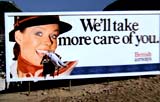 the death of a henchman propelled head-first into a billboard advertising British Airways claiming: "We'll Take More Care of You" - his head appeared consumed by the flight attendant's mouth the death of a henchman propelled head-first into a billboard advertising British Airways claiming: "We'll Take More Care of You" - his head appeared consumed by the flight attendant's mouth |
|
|
(or silents) |
the term for motion pictures without sound (spoken dialogue or synchronized soundtrack), although they were often accompanied by live commentary, piano-music, sound effects, and/or orchestration; the period from about 1895 to 1927 (when "talkies" were introduced); contrast with talkies. |
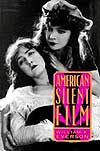
|
|
|
aka "magic bullet" - a solution that completely solves the complicated dramatic problem within a film; the term was derived from European folklore in which only a silver bullet could kill a werewolf. | Example: the silver bullet was used in The Lone Ranger Show (on radio and TV, and later on film) as a symbol of the Lone Ranger's presence to solve various problems. |
|
|
refers to a film element, used by the film-maker to indicate a character's or object's relative strength compared to other things or persons |  Example:
in Citizen Kane (1941), Kane looks massive
compared to wife Susan working on a puzzle and dwarfed in size by a gigantic
fireplace Example:
in Citizen Kane (1941), Kane looks massive
compared to wife Susan working on a puzzle and dwarfed in size by a gigantic
fireplace |
|
|
the optical printing effect of skipping or cutting out certain frames of the original scene to speed up the action | |
|
|
a broad form of comedy in which the humor comes from physical acts or pantomime, frequently harmless violence and pratfalls intended to produce laughter. The name was derived from a device called a slapstick, two boards that slapped together with a loud crack when used to strike something or someone; prevalent during the silent era and in early talkies, with its primary motif being pie-throwing. |
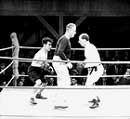 Examples:
Keystone Kops, Charlie Chaplin (here in the extended boxing sequence in
City Lights (1931)), Laurel and Hardy,
Buster Keaton, the Three Stooges, and more recently, Jerry Lewis and Jim
Carrey. Examples:
Keystone Kops, Charlie Chaplin (here in the extended boxing sequence in
City Lights (1931)), Laurel and Hardy,
Buster Keaton, the Three Stooges, and more recently, Jerry Lewis and Jim
Carrey. |
|
|
usually a cheaply-made sub-genre film (usually in the horror genre) designed for the teenage audience (teen movie), deliberately made to contain gory, blood-splattering, explicit deaths without any build-up, style or suspense, often committed by an unstoppable serial killer, with a sharp bladed weapon; most slasher films are created to generate sequels and repetitive boredom; aka splatter films; see also trash film, grindhouse film, schlock film, B-film and Z-film | 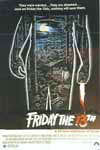 Examples:
Three of the best known, classic slasher films that were commercially successful
include Hitchcock's Psycho (1960), Carpenter's
Halloween (1978), and Wes Craven's A Nightmare
on Elm Street (1984); also the films of Mario Bava and Dario Argento
(i.e. Deep Red (1975)), The Texas Chainsaw Massacre (1974),
Lucio Fulci's Zombie (1979), Sleepaway Camp (1983), the Friday
the 13th franchise; also in the parodies beginning with Scream (1996). Examples:
Three of the best known, classic slasher films that were commercially successful
include Hitchcock's Psycho (1960), Carpenter's
Halloween (1978), and Wes Craven's A Nightmare
on Elm Street (1984); also the films of Mario Bava and Dario Argento
(i.e. Deep Red (1975)), The Texas Chainsaw Massacre (1974),
Lucio Fulci's Zombie (1979), Sleepaway Camp (1983), the Friday
the 13th franchise; also in the parodies beginning with Scream (1996). |
|
|
refers to the digital board held in front of the camera that identifies shot number, director, camera-person, studio and title; the slate has the clap sticks on top and the scene number, take and production name or title usually written on it, and the person operating the slate will say "mark" and clap the sticks for picture and sound sync purposes; originally the data was written with chalk on a slate board; the footage of the slate at the beginning of each shot or take is used in the laboratory and editing room to identify the shot; see also clapboard |
 |
|
|
a movie that is released with little publicity or pre-release buzz, often directed by and starring relatively unknown people, that eventually becomes popular (as a cult film) or financially successful beyond expectations, usually due to positive word-of-mouth; the term is sometimes used incorrectly to describe unpopular movies that the critics love | 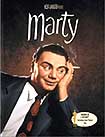 Examples:
Marty (1955), and My Big Fat Greek Wedding
(2002) Examples:
Marty (1955), and My Big Fat Greek Wedding
(2002) |
|
(or slo-motion) |
refers to an effect resulting from running film through a camera at faster-than-normal speed (shooting faster than 24 frames per second), and then projecting it at standard speed; if a camera runs at 60 frames per second, and captures a one second-long event, a 24-frame playback will slow that event to two and a half seconds long; overcrank(ing) means to speed up the camera, thereby making the action appear slower when projected - the term dates back to the old days of physically hand-cranking film through a camera; this filmic technique is usually employed to fully capture a 'moment in time' or to produce a dramatic (or romantic feeling); contrast to fast-motion (or accelerated motion, achieved by undercranking) or time compression | Example: often used in sports films in which the climactic winning catch or play is run in slow-motion |
|
(or shock cut) |
a cinematic term that refers to an abrupt, jarring and unexpected change or transition in the scene or film's image (and the audio) to another scene or image, in order to surprise the viewing audience; see also transition | Example: often used in murder scenes or when a character is suddenly awakened from a nightmare; it also may be evidenced in a sudden cut to a black screen |
| any piece of projected footage during (usually prior to) a motion picture feature presentation that is not a trailer or film presentation, i.e., announcements and theatre promos for the concession stand, courtesy requests and prohibitions (such as turning off cell phones, curbing loud talking, etc.) | ||
|
|
during nominations or awards proceedings, when a prominent, leading, or favored performer/director/crew member or film is inexplicably excluded or denied an award or nomination | Examples: See Academy Awards Mistakes and Omissions |
|
|
a cinematographic effect in which a filter, vaseline or gauze-like substance placed over the camera lens reduces the clarity or sharpness of focus, blurs the image, and produces a diffused, hazy light; the visual effect can also be created by simply shooting out-of-focus; it is often used to enhance romantic or dreamy scenes, or to remove wrinkle lines from an actor's face |  Example: often used in the 1930s; also in the love scene at the French plantation in Apocalypse Now Redux (1979 and 2001) Example: often used in the 1930s; also in the love scene at the French plantation in Apocalypse Now Redux (1979 and 2001) |
|
|
a dramatic monologue delivered by a single actor with no one else onstage; sometimes expressed as a 'thinking aloud' dialogue of inner reflections; delivered by a character to him or herself, or directly to the audience; contrast to an aside. | Examples: See this site's Best Speeches and Monologues section. |